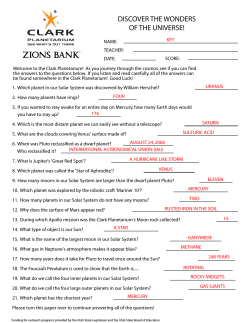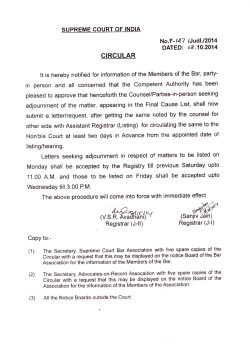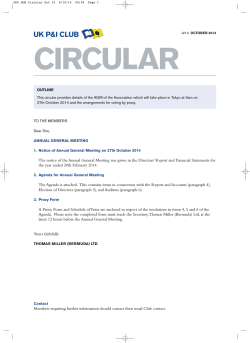
answer key.
Name ___________________ Date _______________ AP Physics I Study Guide Key – Chapter 5 Circular Motion and Gravitation Circular Motion: Key Concepts: • • • • • • Circular motion is motion that repeats itself in circular patterns that return to the starting point. Centripetal force is any force that causes an object to move in a circular path. Uniform circular motion is defined as motion in a circular path at constant speed. Centripetal acceleration is the radially inward acceleration experienced by an object moving in a circular path. The centripetal acceleration is calculated using the equation ac = v2/r. The centripetal force is given by Fc = mv2/r. Review questions 1. A 50 kg skater turns a bend at 7 m/s. If the radius of the curve is 5 m, what is the centripetal force of provided by the friction between the blade of the skate and the ice? 490 N 2. A piece of clay with a mass of 0.3 kg is tied to the end of a string 6.5 m in length and then is whirled around in a horizontal circle at a speed of 6 m/s. a. What is the centripetal acceleration of the clay? 5.5 m/s2 b. What is the centripetal force acting on the clay? 1.65 N c. What is the tension in the string? 1.65 N – this is the centripetal force. 3. If the ball in the previous problem were revolved in a vertical circle instead, what would be the tension in the string at the top and bottom of the ball’s path? Top T = -1.28 N so actually not enough speed to reach the top! Bottom T = 4.6 N 4. At what speed may a frictionless curve of radius 100 m, banked at an angle of 45°, be safely negotiated? v = 31 m/s Law of Universal Gravitation Key Concepts 1. Newton showed that the motion of the planets and stars is governed by the same rules that apply to objects falling near the surface of the earth. 2. The Law of Universal Gravitation states that any two bodies that have _mass attract each other with a force called __ gravity_________. The strength of the force is proportional to the product of the __ masses____ and inversely proportional to the square of the _distance__ between their centers. 3. The gravitational force equation is Where G = 6.673 x 10-11 Nm/kg2 – The universal gravitation constant m1 = mass of object 1 m2 = mass of object 2 and r = distance between the centers of the objects 4. The gravitational force between objects is very weak. It only becomes significant when one of the objects has a very large ___mass________. 5. The mass of an object is the same everywhere but the _weight _(and g)__ is different on each planet. 6. The value of g is different on each planet. On the earth’s surface g = 9.8 m/s2. The formula for finding g on the surface of other planets is: g = Gm/r2 where m = the ___mass_________ of the planet and r = the ____radius ________ of the planet. 7. The acceleration due to gravity (g) varies with height above the surface. The equation is g = Gm/(r + h)2 where r = _____ radius ___________ of the planet and h = ______height__________ above the surface. 8. An object bound by gravity to another object like a planet or a star is a ___satellite__________. 9. The path of a satellite around the object it is bound to by gravity is called the ___orbit_____________. Practice Exercises Use the data table below to complete the exercises. G = 6.673 x 10-11 Nm/kg2 Planet Earth Mars Jupiter Neptune Pluto Mass (kg) 5.97 x 1024 6.42 x 1023 1.90 x 1027 1.03 x 1026 1.40 x 1022 Radius (m) 6.37 x 106 3.37 x 106 6.99 x 107 2.21 x 107 1.50 x 106 Ex. 1 Calculate the gravitational force between two 5 kg bowling balls separated by one meter. 1.7 x 10–9 N Ex. 2 Find the weight of a 65.0 kg at the following locations: a. on the surface of earth 637 N b. 1000 km above the surface of the earth 477 N c. on the surface of Jupiter 1686 N Ex. 3 What is the value of g on the surface of Pluto? 0.42 m/s2 Ex. 4 a. Solve the gravitation equation for r r = sqrt(Gm1m2/F) b. If Mars’ moon Phobos has a mass of 9.6 x 1015 kg, and the Gravitational force between them is 4.6 x 1015N, how far apart are Mars and Phobos? 9.4 X 106 m Kepler’s Laws of Planetary Motion Use the following word bank to complete questions 1-3. faster planets cube slower square distances equal areas focus orbital equal time periods ellipses 1. The paths of the _ planets _ are _ ellipses _, with the sun at one _ focus _. 2. An imaginary line from the sun to a planet sweeps out _ equal areas ___ in _ equal time __ intervals. Thus, planets move __ faster ___ when they are closer to the sun and ___ slower____ when they are farther away from the sun. 3. The _ square _ of the ratio of the __ periods _ of any two planets revolving around the sun is equal to the _ cube __ of the ratios of their average __ distances _ from the sun. If TA and TB are the periods of planets A and B, and rA and rB are their average distances from the sun, the following is true (complete the equation: ( Ta/Tb)2 = ( r1/r2)3 Thus, planets that are closer to the sun have shorter __ orbital ____ periods (a shorter year). 4. Kepler’s third law equation solved for the period is: add this equation to your study guide Ex. 1 Jupiter is 5.2 times further from the sun than the earth is. Find Jupiter’s orbital period in Earth years. 11.9 Years Ex. 2 Neptune’s mean distance from the sun is 4.5 x 1012 meters. The mass of the sun is 1.99 x 1030 kg. What is Neptune’s orbital velocity and period? v = 5400 m/s , T = 165 years Practice Test Answers: 1. B 2. B 2. A 4 D 5. B 6. D 7. D 8. B 9. B 10. A and B 11. a. FG = b. a = c. g’ = d. v = e. T = , less than g on Earth 12. a. FT FT b. Vmin = √(Rg) c. V = √(R( – g)) d. Motion tangent to the circle: Velocity is upwards, acceleration is g down
© Copyright 2025

















![± Gravity on Another Planet Exercise 13.4 Week 12: Chapter 13 [ Edit ]](http://cdn1.abcdocz.com/store/data/001596999_1-45a335ad6a70cce79963d2a703fea0b6-250x500.png)



